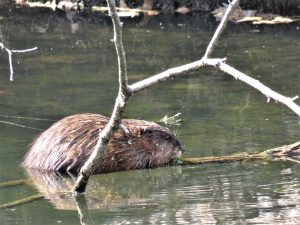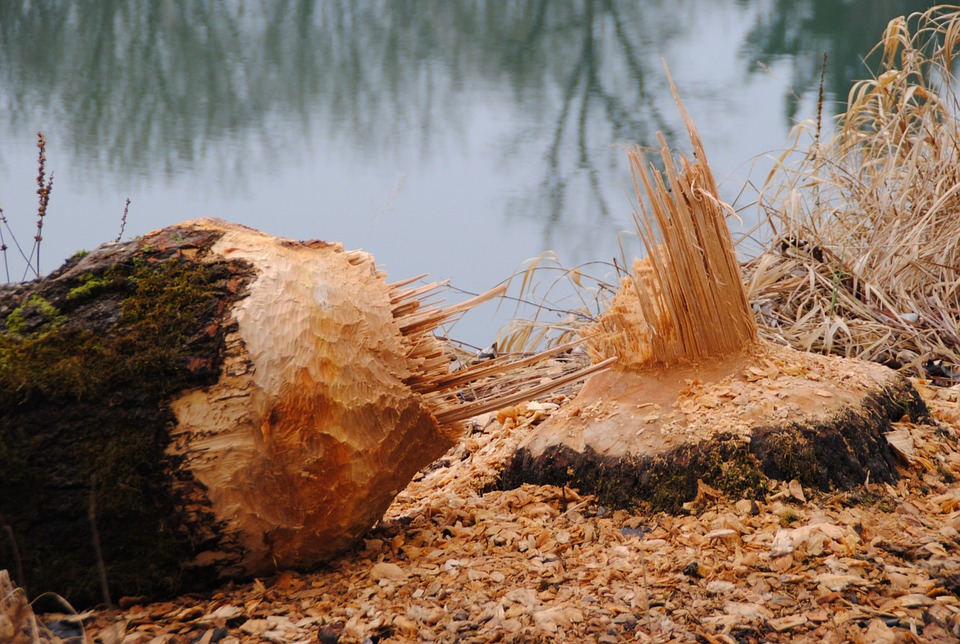Semi-aquatic wildlife are not the first thing Minnesota homeowners worry about, but they cause significant damage to waterfront properties each year. The chief offenders in the Twin Cities region are beaver and muskrat. These two species differ significantly from one another, but have some overlap in their damaging behaviors.
Common Beaver Damage:
 Damaged or felled trees
Damaged or felled trees - Destabilized lawn
- Burrowed and eroding shoreline
- Plugged culverts and drainage tiles
- A visible lodge of sticks and mud
- A dam blocking water flow
- Flooding
Common Muskrat Damage:
 Collapsed shorelines and lawns from subterranean burrowing: Muskrats will construct burrows with underwater entrances that can extend far into lawns and adjacent shoreline areas. These shallow underground burrows will often collapse underfoot or when mowed over.
Collapsed shorelines and lawns from subterranean burrowing: Muskrats will construct burrows with underwater entrances that can extend far into lawns and adjacent shoreline areas. These shallow underground burrows will often collapse underfoot or when mowed over.- Plugged culverts and drainage tiles
- Feeding damage to native shoreline vegetation, ornamental and agricultural plantings
- Damage to watercraft:
- Chewed rubber of inboard motor seals, wiring, and plastic hoses
- Soiled areas from feeding platforms and toilet areas
- Damage to fountains and irrigation systems: Chewed water supply tubing and electrical wiring harnesses
- Docks and shoreline structures:
- Muskrats will set up residence in, on or under many styles of docks and boathouses
- When so equipped, dock floatation devices can have severe chewing damage
- Damage to seawalls, dikes, embankments, retaining walls, rip-rap and other shoreline landscaping: Burrowing can undermine the structural integrity of these areas
- Damage to pond liners and aerators: Chewing and burrowing will compromise these areas
The establishment of new dens, lodges and burrows typically occurs during dispersal events when juveniles strike out on their own, or when a colony is displaced for some other reason. The building of these lodges is responsible for new shoreline burrowing and erosion, dam construction, and drainage plugging activities.
Much of the other listed damage is tied to the feeding patterns of these species and takes place year round. Neither species hibernates, though beaver will store food caches while muskrat will forage beneath the snow and ice.
How To Manage Beaver & Muskrat
What, then, can be done about the damage these activities create? A trapping program is the most efficient way to get rid of a visiting semi-aquatic animal or resident colony with a burrow, den or lodge on or near your land.
 Wildlife control operators are trained to inspect for these animals, effectively trap them, and leave no colony members behind. This is an important step in stopping further damage to your lawn, trees, vegetation, landscaping or shoreline. Once the animals have been removed, efforts at deconstruction of any new dam can begin and damage to your landscaping will cease.
Wildlife control operators are trained to inspect for these animals, effectively trap them, and leave no colony members behind. This is an important step in stopping further damage to your lawn, trees, vegetation, landscaping or shoreline. Once the animals have been removed, efforts at deconstruction of any new dam can begin and damage to your landscaping will cease.
Unfortunately, conditions that are lucrative to muskrat or beaver once will usually remain so. There is always the potential for a dispersing animal to find the vacant lodge or den and move in. A wildlife control operator can walk you through how to minimize the allure, but homeowners should be aware that habitat modification measures are rarely feasible and always inordinately expensive due to the scope of work involved.
A site may remain vacant for many years, or it may be recolonized during the next dispersal period. Site specific conditions raise or lower the likelihood of this event, but generally speaking the potential for recolonization always exists.
Trusted Semi-Aquatic Wildlife Management
If you are a resident of the Twin Cities metro area and have an issue with Beaver or Muskrat damage to your property, give our experienced professionals a call today. Inspections can be scheduled to identify the scope of your issue, and a quote provided for an abatement program.

